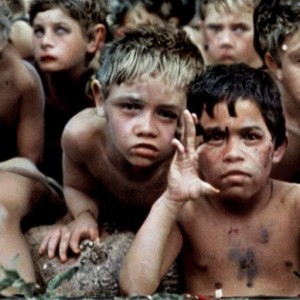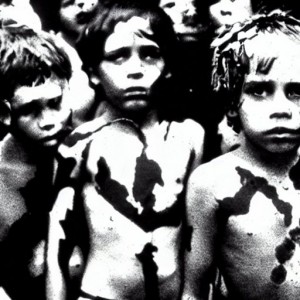Philosophical novel-parable “Lord of the flies” by William Golding has first seen the light of day in 1954. At first, many publishers did not want to accept the manuscript by an unknown author, but, after the novel had been printed, it immediately caught the attention of readers and critics alike. Simple plot, realistic images of children, psychologically precise background of character actions and exotic place of action have merged in “Lord of the flies” into a terrifying dystopia that depicts the “brutality” of man.
During the twentieth century, the majority of literature scientists viewed “Lord of the flies” as a warning, a depiction of what could be the result of following Nazism and fascism ideologies. However, political part of the work is just one of historical circumstances, while the meaning of the novel is much more vast and universal. In his novel, Golding shows not concrete ideas that belong to a particular period, but rather timeless human nature – sinful, terrifying, and willing to commit the worst of crimes without the constraints of a positive influence.
The beginning of the novel is a moment of meeting of two boys, Ralph and Piggy. Boys, who`ve met after a plane crash, are trying to understand what has happened to them and to start looking for a solution for their problem. British boys (children, aged 5 to 6 years, and teens, aged 10 to 13 years), gathered by a horn call of a conch, at first try to preserve culture and civilization of their home county on the island.
The boys lay down the rules, the most important of which is the constant upkeep of the smoking bonfire. Fire in “Lord of the flies” becomes the symbol of life; it serves as a hope for survival, children use it to warm themselves and chase the night scares away. Children build tents for protection from rain; there is a designated place for a privy. Older boys help the little ones to reach high hanging fruits. The life on the island goes almost perfectly: 12 years-old Ralph perceives the new world without adults as a fairytale, where everything is fine. Other children, at first, relate to what happened to them as a game: the little ones build sand castles on the seashore and former choirboys, led by Jack Merridew, become hunters.
The first blood changes everything. When Jack realizes he is capable of killing a piglet, hunting becomes a lifestyle rather than amusement. Following their leader, former choirboys change beyond recognition: they paint their faces with bloodthirsty masks and surrender themselves fully to the bloodlust. The feeling of self-importance and power outshine everything – including desire to return to a human world. At first, hunters abandon the bonfire, and then completely turn into the wild tribe lead by a Chief, whose orders are followed unquestionably. New civilization, drunk with overindulgence, consumed by the overwhelming fear of the unknown Beast, decides to pacify it with a terrifying boon – a severed pig`s head on a stick. When the head becomes rotten, flies gather around it, turning the previously grisly item into materialized image of Evil.
The image of The Beast in the novel refers to the image of The Devil (“lord of the flies” translates from Hebraic as Beelzebub). The Beast firstly appears in the nightmares of the kids, who see it as a snake hanging on trees. Optimistic Ralph considers Beast a fiction, Piggy denies its existence, basing it on a scientific knowledge of the world, and the rest of the boys are secretly afraid what could kill them, not knowing that they should be afraid of, firstly, themselves. This knowledge is revealed to only one boy – the weakest and, consequently, the smartest – constantly falling unconscious Simon. While facing the pigs head, he starts talking to it in his mind, where he receives the clear answer that The Beast is an inseparable part of him.
The ultimate Beast consists of the sum of little beasts. These beasts are what becomes of the hunters, who began with killing pigs and ended with killing their kin. At first, the hunt is disguised as a game: one boy portrays a pig and the rest of the boys “pretend to hunt and kill “it”. Then brutal instincts of once civilized kids reveal themselves and the murder is committed for real.
Ralph, Piggy and twins Eric and Sam, who become unconscious witnesses and, perhaps, accomplices, of the murder of Simon, are so shocked by the event, that they try to pretend it did not happen. Nobody of the boys wants to remember the “dance”, but when it becomes unavoidable, everyone decides to support the version that what happened to Simon was a tragic accident. The following murder of Piggy, that happens in the light of day, and the manhunt for Ralph serve as a culmination of the novel. Now finally gone mad, the children unleash their inner Beast and stop only in front of a more formidable, creative force – an English officer, who landed the island. He becomes the image of the higher divine force, who ended all the conflicts in a moment and with his presence alone defeated the Devil.
Literary images of the boys correlate to a concrete human origin: Ralph is kind, cultured, striving for order, not afraid of responsibility; Piggy is a tongue-tied, smart, able to reason inventor; Simon – weak philosopher – individualist; Jack is a dictator, hungry for power; Roger – an adulatory servant and a cruel sadist; twins Eric and Sam – simple people, going with the stream, who sympathize good but bow before brute force; the little ones are not yet full personalities, who did not yet choose between good and evil, but who can feel the latter intuitively.
An uninhabited island in “Lord of the Flies” becomes symbolic portrayal of the Earth, where civilizations are created (community of Ralph and Piggy) and destroyed (Jack`s tribe), new nations form (separation of the boys on two camps), diplomatic relationships start (Ralph – Jack), wars occur (Jack, Morris and Roger attach Ralph and Piggy) and new religious beliefs are formed (worship of “The Lord of the Flies”).

